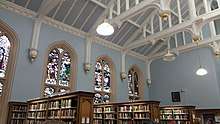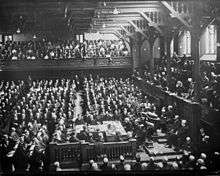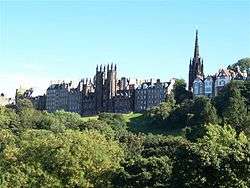New College, Edinburgh
New College in The University of Edinburgh is one of the largest and most renowned centres for studies in Theology and Religious Studies in the UK, with students in M.A., M.Th. and Ph.D. degree programmes coming from over 30 countries.[1] There are now nearly 40 full-time members of the academic staff, and they include internationally respected scholars in various specialities.[2]

New College originally opened its doors in 1846 as a college of the Free Church of Scotland, later of the United Free Church of Scotland, and from the 1930s has been the home of the School of Divinity (formerly the Faculty of Divinity) of the University of Edinburgh. As "New College" it continues the historic commitment to offer a programme of academic preparation for ministry in the Church of Scotland, also made use of by ministerial candidates from other churches. In the 1970s the Faculty of Divinity also began offering undergraduate degrees in Theology and Religious Studies, and students in these programmes now make up the majority of the nearly 300 undergraduates enrolled in any given year.[3]
History
The founding of New College came as a result of a religious conflict that emerged out of the Disruption of 1843 in which clergy and laity left the established Church of Scotland to establish the Free Church of Scotland – free from state connections and submitting only to the authority of Christ. New College was established as an institution to educate future ministers and the Scottish leadership, who would in turn guide the moral and religious lives of the Scottish people. New College opened its doors to 168 students in November 1843 and, under the guidance of its first principal Thomas Chalmers, oversaw the construction of the current building in 1846.[3] At the formation of the United Free Church, the United Free Church was granted the buildings, and the continuing Free Church operated from new premises in 1907.[4] This Free Church College was renamed Edinburgh Theological Seminary in 2014.
Prior to the 1929 reunion of the Church of Scotland, candidates for the ministry in the United Free Church studied at New College, whilst candidates for the old Church of Scotland studied in the Divinity Faculty of the University of Edinburgh. During the 1930s the two institutions came together, sharing the New College site on The Mound. "New College" can designate the site itself, or the legal entity that continues to function in an official relationship with the Church of Scotland, the Principal of New College appointed by the General Assembly of the Church of Scotland and responsible particularly for Church of Scotland candidates for ministry. The current principal is the Reverend Professor Susan Hardman Moore. As the "School of Divinity," however, it is a unit in the University of Edinburgh with a much wider remit, and is led by the Head of the School of Divinity (currently Professor Helen Bond), who is appointed by the University, and who oversees the larger academic and financial operation. Over the years, a number of notable figures have been among its academic staff, including Robert Rainy, Thomas Chalmers, Hugh Ross Mackintosh, James Barr, Thomas F. Torrance, James S. Stewart, John Baillie, John McIntyre, Ruth Page, Norman Porteous, Marcella Althaus-Reid, Andrew F. Walls, David Fergusson and others.[5]
Academics
Members of academic staff are all employees of the University of Edinburgh, and are today an international body of scholars of various persuasions in religious matters.
Academic Ratings

New College is rated among the best schools of theology, philosophical theology, and religious studies in the UK, according to the most recent national Research Excellence Framework.[6]
Undergraduate
The School of Divinity offers six different undergraduate (Honours) degrees. The MA Theology allows students to focus on traditional areas of Christian studies (Biblical Studies, Ecclesiastical History, Christian Ethics, and Systematic Theology). The MA Religious Studies introduces students to the methods of the study of religion and a variety of religious traditions such as indigenous religions, Islam, Judaism, Christianity, Buddhist and Hindu traditions. The Bachelor of Divinity prepares candidates for the ministry (and is open to other interested students also). The MA Religious Studies and English/Scottish Literature, the MA Philosophy and Theology, and the MA Divinity and Classics allow students to work cross-disciplinary.[7]
Postgraduate
The School also offers several M.Th., M.Sc. and M.Res. degree programmes[8] (Biblical Studies, Science and Religion, Theology in History, Theology and Ethics, World Christianity, Islam & Christian–Muslim Relations, and Religious Studies), and is an internationally known centre for PhD studies in a broad spectrum of specialities. There is no confessional test for staff or students. Only a portion of the undergraduate students are ministerial candidates, and the majority enter a variety of careers after studies (e.g. teachers, libraries, TV/radio production, civil service, further professional studies in law, finance, social work, etc).
Research Centres
New College is home to several research centres: the Centre for the Study of World Christianity (established by Andrew F. Walls, which has its own collection of archival material on the history of Christian missions); the Centre for Theology and Public Issues; and the Centre for the Study of Christian Origins.[9]
Facilities
New College is located in the city centre on Mound Place (on The Mound), overlooking Princes Street Gardens, the Scottish National Gallery, and Princes Street. The neo-gothic building was designed by the respected 19th century architect William Henry Playfair.
Library

The New College library was founded in 1843 as the Library of the Free Church College. It is the largest single-site theological library in the United Kingdom, holding a large collection of manuscripts, including the papers of Thomas Chalmers, John Baillie, J. H. Oldham and James S. Stewart.[10][11]
The library is situated in the eastern wing of New College, and its splendid reading hall was originally built as the sanctuary of the Free High Kirk.
Rainy Hall
Rainy Hall is a gothic revival dining hall, adorned with heraldry and featuring a hammerbeam roof. It is at the centre of college life, used by students and faculty for conversation and meals.[12]
General Assembly Hall

As well as the teaching facilities and the library, the New College complex also includes the General Assembly Hall of the Church of Scotland, which, however, remains the property of the Church, and is where annual meetings of the General Assembly of the Church of Scotland are held.[13] This hall was used during the famous Edinburgh 1910 World Missionary Conference and was the temporary home for the debating chamber of the Scottish Parliament from its establishment in 1999 until the completion of the new Scottish Parliament Building at Holyrood in 2004.[14]
References

- "School of Divinity, University of Edinburgh". www.ed.ac.uk. University of Edinburgh. Retrieved 18 August 2016.
- "Academic Staff". www.ed.ac.uk. University of Edinburgh. Retrieved 17 February 2018.
- Brown, Stewart J. (1996). "The Disruption and the Dream: The Making of New College 1843–1861". In Wright, David F.; Badcock, Gary D. (eds.). Disruption to Diversity: Edinburgh Divinity 1846-1996. Edinburgh: T&T Clark. pp. 29–50. ISBN 978-0567085177.
- "Bachelor of Theology". Edinburgh Theological Seminary. Archived from the original on 15 December 2018. Retrieved 13 December 2018.
- Shaw, Bill (1996). "Dual Identity: Church College and University Faculty". In Wright, David F.; Badcock, Gary D. (eds.). Disruption to Diversity: Edinburgh Divinity 1846-1996. Edinburgh: T&T Clark. pp. 169–185. ISBN 978-0567085177.
- "Teaching & research excellence". www.ed.ac.uk. University of Edinburgh. Retrieved 21 April 2016.
- "Degree Programmes". www.ed.ac.uk. University of Edinburgh. Retrieved 21 April 2016.
- "Taught programs". www.ed.ac.uk. University of Edinburgh. Retrieved 17 February 2018.
- "Research centres". www.ed.ac.uk. University of Edinburgh. Retrieved 21 April 2016.
- Howard, John (1996). "New College Library". In Wright, David F.; Badcock, Gary D. (eds.). Disruption to Diversity: Edinburgh Divinity 1846-1996. Edinburgh: T&T Clark. pp. 187–201. ISBN 978-0567085177.
- "New College Library". www.ed.ac.uk. University of Edinburgh. Retrieved 21 April 2016.
- "Rainy Hall". www.scottish-places.info. Retrieved 21 April 2016.
- "The General Assembly: a guide to what goes on". www.churchofscotland.org.uk. Retrieved 21 April 2016.
- Jones, Clyve, ed. (2009). A Short History of Parliament: England, Great Britain, the United Kingdom, Ireland and Scotland. Suffolk: The Boydell Press. p. 359. ISBN 978-1843835035.
Further reading
- Watt, Hugh (1946). New College, Edinburgh: A Centenary History. Edinburgh: Oliver & Boyd.
- Wright, David F.; Badcock, Gary D., eds. (1996). "The Disruption and the Dream: The Making of New College 1843–1861". Disruption to Diversity: Edinburgh Divinity 1846-1996. Edinburgh: T&T Clark. ISBN 978-0567085177.
.jpg)